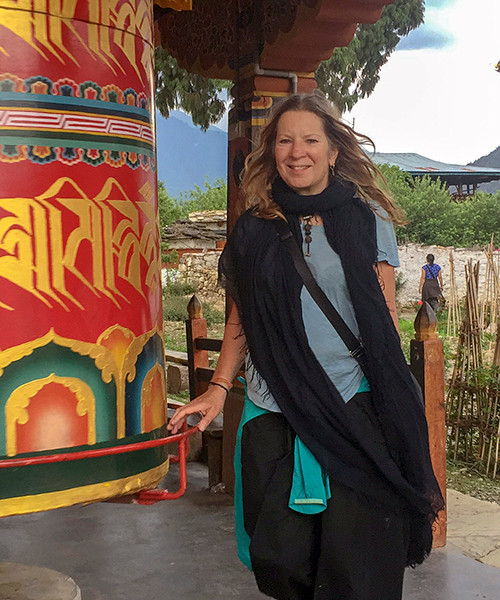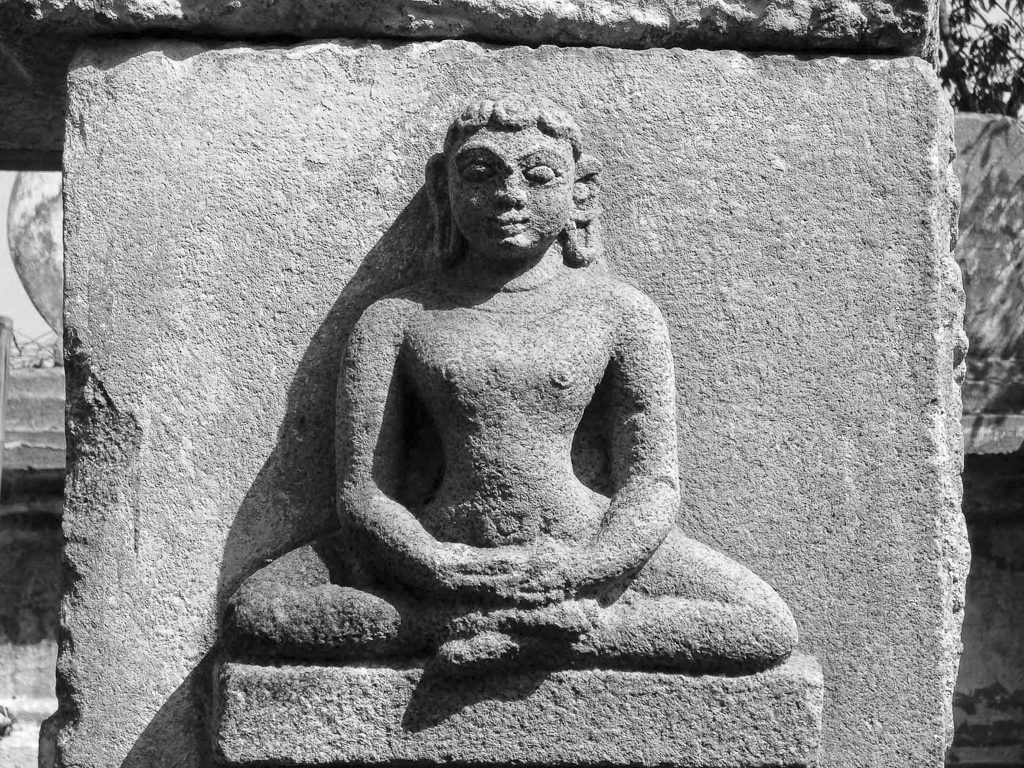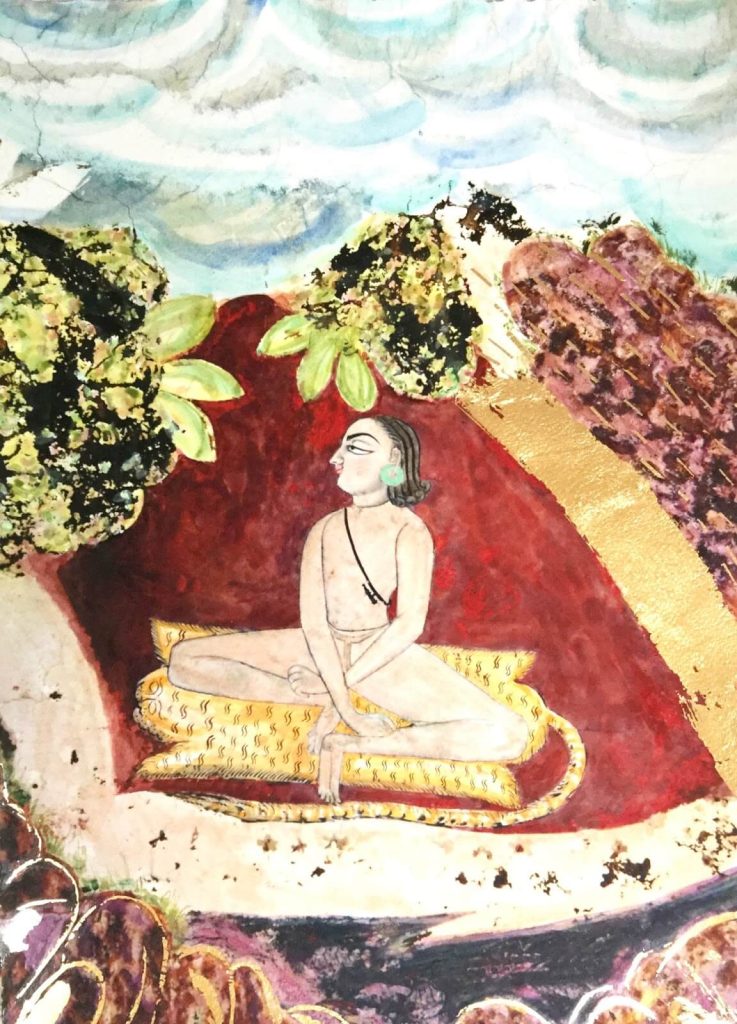A yoga history in a mustard seed
by Heather Elton
T H E U P A N I S H A D I C A G E \ P R E – C L A S S I C A L Y O G A
It’s a daunting task to try to distill the essence of the Upaniṣads. The Upaniṣads (800-200 BCE)are the foundational philosophical texts of Hinduism and played an important role in the development of spiritual ideas in ancient India, marking a transition from Vedic ritualism to new innovative ideas in terms of philosophy and practice. They are divinely revealed philosophical teachings that search for the ‘truth’; the reality underlying the world of manifest reality of experience. They reveal liberating insight and experiential wisdom, and contain the first descriptions of yoga practice.
They are the last bit of ‘divinely revealed’ teachings known as Shruti. They are commonly known as Vedānta or as the ‘end of the Vedas’. The ancient Upaniṣads are technically still part of the Vedas,but everything from this point forward – the epics like Ramayana, Mahabharata and the Bhagavad Gita, and Patanjali’s Yoga Sutras – are known as Smriti; that which are remembered and shared by human creators.
Upaniṣads are also known as Vedānta. Veda + anta = Vedānta = end of the Veda.
Upanishad means ‘sitting down near;’ people discoursing at the edges of towns, or at the feet of the guru, about the existence of the soul (Ātman) and retreating to the forests to practice yoga and experience Ultimate Truth and attain liberation (Mokṣa). The Upaniṣads ask The Big Questions: What is the Self? What happens after death? What is real and what is not? It was a time of discernment and Jnana (wisdom) that could lead to liberation.

Above, Sitting down at the feet of the guru to hear the teachings.
The Upaniṣads are the path of KNOWLEDGE, as opposed to a path of ACTION in the Vedas. Rituals and sacrifice are still the happening in the early Upaniṣads and it isn’t until the later Upaniṣads (700 BCE – ) that people are concerned with liberation through the path of Knowledge (Jnana). And this could occur through your own ‘direct perception’, like a Rishi ‘seeing,’ the embodied the Truth, rather than through the mediator of a Brahmin priest.

108 Upaniṣads are known, of which the first dozen are the oldest, and most important, and are referred to as the Principal Upaniṣads.They are considered to have been composed in northern India, bound on the west by the upper Indus valley, on the east by lower Ganges region, on the north by the Himalayan foothills, and on the south by the Vindhya mountain range. This region covers modern Bihar, Nepal, Uttar Pradesh, Uttrakand, Himachel Pradesh, Haryana, eastern Rajasthan, and northern Madhya Pradesh. The later Upaniṣads recorded in the Muktika canon belong to an entirely different region, probably southern India, and are considerably more recent. For centuries, the Upaniṣads were memorised by each generation and passed down orally.
Scholars are uncertain about when the Upaniṣads were composed. Patrick Olivelle, in his book The Early Upaniṣads, says that “in spite of claims made by some, in reality, any dating of these documents [early Upaniṣads] that attempts a precision closer than a few centuries is as stable as a house of cards.” It’s probably safe to say that the early Upaniṣads all predate the Common Era and five of them are believed to be pre-Buddhist (6th century BCE). Most were composed from the last centuries of 1 BCE through 15 CE and the New Upaniṣads, beyond the 108 in the Muktika canon,continued to be composed through the modern era. All the texts are written by Brahmin men so the perspective is very narrow. For the most part, Vedantic philosophy is placed in a male, theist, Vedic world.

In terms of a chronology for the early Upaniṣads, or Principle Upaniṣads, Patrick Olivelle sites the Brhadaranyaka and Chandogya as the two earliest. They are pre-Buddhist and may be placed in the 7th to 6th centuries BCE, give or take a century or so. Three early prose Upaniṣads – Taittiriya, Aitareya, and Kausitaki – come next; all are probably pre-Buddhist and can be assigned to the 6th to 5th centuries BCE. The Kena is the oldest of the verse Upaniṣads, followed by the Katha, Isa, Svetasvatara, and Mundaka, all composed probably in the last few centuries BCE. The two late prose Upaniṣads, the Prasna and the Mandukya, cannot be much older than the beginning of the Common Era.
Stephen Phillips, in his book, Yoga, Karma, and Rebirth: A Brief History and Philosophy, places the early Upaniṣads in the 800 to 300 BCE range. He summarises the current Indological opinion to be that the Brhadaranyaka, Chandogya, Isha, Taittiriya, Aitareya, Kena, Katha, Mundaka, and PrasnaUpaniṣads are all pre-Buddhist and pre-Jain, while Svetasvatara and Mandukya overlap with the earliest Buddhist and Jain literature. Personally, I find it interesting to try to determine which came before/after Buddhism because that philosophy, which emerged during the Upanishad Era, created a major shift in thinking from a dualist view to one of non-dualism.
The Principal Upaniṣads include:
Brihad-Aranyaka
Chandogya
Taittiriya
Aitareya
Kaushitaki
Kena
Katha
Isha
Svetasvatara
Mundaka
Prashna
Mandukya
(The texts in bold are pre-Buddhist and Jain, and the ones in orange mention yoga.)

Above, Devotees came to have Darshan and hear the teachings from the guru yogi in the mountains, forests and jungles.
What kind of knowledge is being shared in the Upaniṣads? One that can’t be described. Words are inadequate to describe the vastness of concepts like the Self, Ultimate Reality, or consciousness. Even Sanskrit is woefully limited. Ultimate Truth is ungraspable. All the Upaniṣads really do is point towards ‘liberating insight’. But they do establish the preconceptions of Indian thought that became established in early yogic practices.
- Karma (action)
- Saṁsāra (Wheel of Life)
- Duḥka (suffering)
- Mokṣa (liberation)
And the enduring chariot metaphor to define yoga is first seen in the Upaniṣads.
Key Concepts
If the hymns of the Vedas emphasise rituals, the spirit of the Upaniṣads is inherently opposed to ritual. The Maitri Upanishad states,

Vedic gods such as Agni, Indra, Rudra, Vishnu and Brahma, were conflated in the Upaniṣads to the supreme, immortal, and incorporeal Brahman- Ātman. God becomes synonymous with self, the inmost being of each human being and within every living creature, and is declared to be everywhere.
The Principal Upaniṣads introduced new ideas about the Self/Soul, or the existence of an ‘inner core’ – Ātman – that is identical to Ultimate Reality (Brahman). I am Ātman (Individual Self). Ātman = Brahman (underlying reality of all existence). I am Brahma (God). Brahma = OM (the syllable that contains everything and the Supreme Reality). Brahman is ‘real behind the real.’ There is no separation. Everything is ONE. Avidya (ignorance) prevents us from seeing or knowing this. This might be the source of the idea that yoga means ‘union’, as well as later in Tantra.
Here are a few of the key concepts explained:
I am Ātman
The only way to find the ‘shining inner core’ of the Individual Self is to use deductive logic that discerns what the Ātman is NOT, and in the process, we might find out who we really are.


Ātman = Brahman
Brahman is the underlying reality of all existence, if only we could see that. I am Brahma (God). There is no technique. Don’t try to see anything. Instead you must strip away any attempt to see anything. Then Brahman will be revealed, like a flash of lightning – the real behind the real – and we’ll see that there is no separation. Everything is one.

The Real behind the Real
But what does the ‘real behind the real’ mean? Essentially, our perception of reality is misapprehension, or an illusion/delusion, that we are separate from everything around us. The more we identify with the illusion, through our conditioned behaviour – avidya (ignorance) -the less chance we have of seeing reality as it really is.
The Upaniṣads describe the universe, and the human experience, as an interplay of Purusha (the eternal, unchanging principles, consciousness) and Prakriti (the temporary, changing material world, nature). These concepts are explained in more detail in the Samkhya section of this article. Purusha manifests as Ātman (soul, self), and Prakriti as Māyā. Knowledge of Ātman is considered as ‘true knowledge’ (vidya), and Māyā as lack of awareness or lack of true knowledge (avidya).
Māyā, or illusion, is an important idea in the Upaniṣads. The texts assert that in the human pursuit of blissful and liberating self-knowledge, it is Māyā which confuses and distracts an individual and obscures true knowledge. To say that the universe is an ‘illusion’ doesn’t mean that the world is not real and simply a figment of the human imagination. Māyā means that the world is not as it seems to be; the world that one experiences is misleading as far as its true nature is concerned. Māyā is the perceived changing reality and it co-exists with Brahman which is the hidden true reality.
So, we need to strip away the veils of Māyā that obscure our vision. Much of this has to do with the ego ‘I’. If we can expand our consciousness to include everything and stop the personal narrative, we will see that this is true.
Guidance
If this is too difficult, we can always request guidance. The Asato Ma mantra serves this purpose and comes from the Upanishadic Era.

Brahman = OM
Not only is Ātman = Brahma, but everything can be summed up in one syllable – OM. So, instead of there being no words, there is one syllable that contains everything and is the Supreme Reality.


Everything in the past and the future has either happened or has yet to come. It’s all happening NOW. When we chant OM, we can dissolve the world of habitual patterns and conditioning to experience the ongoing moment in which everything unfolds. For the Rishis, sound created the world. Its vibration created mind, which creates form. Namarupa. OM is the embodiment and the vibration from which everything emerges.
There are three potential states of consciousness: Waking, dreaming, state of deep sleep. In deep sleep, our storyteller, ego mind is not active. Can’t really ‘do’ anything. Unconscious. It’s as close as we get to experience a state beyond the mind. In the dream state, the story teller tells a story, but we know its illusory. In the waking state, we’re lost in the world of ‘me’. Beyond that is the fourth state – a place beyond the stain of our own perception and the manufactured illusion we have of the world.
Many yoga practices begin with chanting to set the proper context and to awaken the yoga processes. By chanting OM, we hear three syllables A-U-M and feel the vibration continue after audible sound trails off into silence. This tapering off to a sound point behind the soft palate is known as anuswara (also considered to be bindu or nectar). The dot symbol at the top of AUM signifies anuswara and represents the fourth state of consciousness. As sound disappears into silence, our mind dissolves into the vibration itself and taps us into a sense of kindness and compassion. We understand that there is no separation. This allows for the initial sense of awe, or release, that allows us to begin our practice.
New concepts in the Upaniṣads like Brahman (god), Ahimsa (non-harming), Duḥka (suffering), Māyā (illusion), Saṁsāra (Wheel of birth, death and rebirth), Mokṣa (liberation), led to a profound shift of consciousness and the world was never seen the same way again. It eludes most of us, but we can have a ‘taste’. The residue of vibration of OM. The pause at the end of the exhale. Absence of mind. No need of anything. No conditioning. Just presence. Appreciation of existence. The unwinding of time back to the state of unmanifest. The pristine state before separation emerges and the senses create form.
© Heather Elton Photography. Jain monk at Shravanbelagola in Karnataka, India.
Yogis in the Axial Age
R e n u n i c a t e s | R e n o u n c e r s | S h r a m a n a s | A s c e t i c s
800 – 250 BCE
During the later Upanishadic era social upheaval occurred and the ‘Brahmanical tradition’ was challenged. During the Vedic Age, Brahmins weren’t interested in liberation (Mokṣa), preferring people to work and pay taxes. Around 800-500 BCE, a new spiritual landscape began to emerge. An unorthodox, śramaṇa movement gained momentum and some people renounced worldly life to get away from the production of karma, of consequences, that spans many lifetimes, leaving their homes to practice yoga in the jungles and forests. Forest rishis, silent Munis, tapasya yogis (extreme practices involving heat), reclusive skull-bearing Pashupatas who worshiped Shiva, and others, who organised into monastic groups, sought ‘direct experience’ from their yogic practices and radical new ideas emerged. Liberation (Mokṣa) is the best word to describe this era. Buddhists and Jains opposed animal sacrifice saying that sacrifice hasn’t helped anyone to resolve any problems. Buddha said that you didn’t need a Brahmin priest and empowered people to attain liberation by themselves. The innovative and diverse ideas stemming from the Ascetic Movement, or Renunciate Movement, led to a revolt against Brahmanical control of the world resulting in the end of the Vedas.
Early yogis were concerned about Karma, or the repercussions of our actions in life. Ātman is perceived as both grasper and the grasped. It’s a shiny spectator, uncreated and everlasting, and does not take on the stain of Karma. Unless we resolve the karmic dust, we are bound to in the Wheel of Saṁsāra – life, death, rebirth. The karmic dust is what reincarnates. Yogis became obsessed with the idea of purification as a means to free ourselves from cyclical existence.

Two most important, and enduring, religions -Buddhism and Jainism – arose out of the ascetic movement. Both were concerned with ideas of karma, rebirth, and liberation from the Wheel of Saṁsāra, or the Wheel of Karma. Mahavira (600 BCE), the guru of the Jains, introduced the idea of Ahimsa (kindness or non-harming / non-violence) as the means to slow down the Wheel of Karma. This was the birth of ethics (yamas and niyamas) and by the end of the Upanishadic era had become a central theme. The Jain solution to the problem of karma was to do as little as possible. Act less = less karma. Do nothing. Sit still. Meditation became the main yoga practice at this time. The Immobility Aesthetic was born.
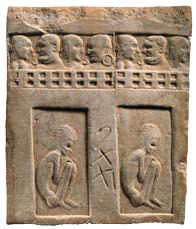 The Immobility Aesthetic. Early sculpture of Jain monks in meditation.
The Immobility Aesthetic. Early sculpture of Jain monks in meditation.
Gautama Siddhartha Buddha (404 – 486 BCE?) was born as a Prince, but renounced his luxurious life at the palace for the spiritual path. He was part of the Shakya tribe and is also known as Shakyamuni Buddha. He became an ascetic yogi and experimented with extreme tapasya practices, like Kechari Mudra (swallowing the tongue and placing it behind Agna Chakra to collect Bindu), strong prāṇāyāma retentions (kumbhakas), and fasting, but after many years studying with the most accomplished yogis of the day, and starving himself for 6 years, he came to the conclusion that extreme asceticism wouldn’t lead to liberation. He chose the Middle Path. (The practices that the Buddha dismissed are the forerunners of early Hatha Yoga, which will be discussed in the chapter on Early Hatha Yoga.)
Gautama Buddha ‘awoke’ under the Bodhi Tree at Bodhgaya. ‘Enlightenment’ is not a word Buddhists use. Liberation is not about ‘getting something’; it’s about removing the obscuration of māyā, or the elimination of karmic dirt. Our own true nature, or Buddha Nature, is already perfect if only we could see this. It’s impossible to synthesise the vast canon of Buddhist philosophy, (I get into a bit more depth in the Buddha section of this article), but the essence of what Buddha realised under the Bodhi tree is that everything is compounded and therefore impermanent. And our misunderstanding of this, leads to craving/desire and having attachment to things we believe are permanent – a misconception that leads to suffering/ Duḥka. Buddha taught the 4 Noble Truths as the path leading to the cessation of suffering and offered people a way out of the cyclical existence of Saṁsāra.
Buddha re-visioned the Wheel of Saṁsāra. The basic doctrine of Saṁsāra is that ACTION = KARMA. Desire leads to action, which creates samskaras or imprints, that deepens our habitual patterns. Clusters of samskaras become vasanas that emerge as desires that are expressed as new action and more karma. Reincarnation is a cornerstone of Buddhism. Buddha offered a way out of the cycle, saying that karmic effects did not result from one’s physical acts, but through one’s desires and intentions. Desire had to be uprooted, and no degree of asceticism, no insight into the true nature of the soul could bring about this destruction. Intention is more important than action. Only through good intentions and rigorous mental transformation, in the form of meditation, can we reduce vasanas/samskaras and not create new karma that leads to rebirth. Nirvana is when there is death without rebirth; something the Buddha chose at the time of death.

Buddha refuted early Upanishadic beliefs both through deductive logic – ‘Not this. Not this.’ – and analytic inquiry. He disagreed with the premise that Ātman = Brahman. Buddha argued that Upanishadic inquiry failed to prove the existence of Ātman, and because there is no evidence, then there is no creator god and no inherent ‘self.’ He argued against the existence of the ‘inner core.’ No Ātman. There is no soul; and no creator god.

© Heather Elton Photography. Buddha reclining in Paranirvana at Ajanta Caves in Maharastra, India.
Similarities and differences with Buddhist teachings
I think it’s fair to say that Buddha was a product of the causes and conditions of his time and that he was both influenced by many early Upanishadic ideas and that his philosophical ideas influenced the later Upaniṣads. The Maitri Upanishad, in particular, written after the time of the Buddha, contains similar ideas, or at least awareness of Buddhist teachings. In it we find the earliest Sanskrit literary usage of the term samādhi (absorption), a word also found in early Buddhist texts. However, similar concepts of ‘meditation’ and ‘union’ are older than the use of the term samādhi and appear in the Brihad-Aranyaka Upanishad. Other words and ideas such as the contemplation of the organic substances of the body have a Buddhist flavour and are shared between Maitri Upanishad and earliest known Buddhist texts.
Maitri Upanishad explicitly mentions, in seventh Prapathaka, a sect of thought whose teachers wear “reddish robes”, who deny the “existence of soul/self”, who preach a “dharma destructive of Vedas and Upaniṣads” and whose goal is hedonistic “attainment of pleasure”. This description could refer to many members of the Sramana movement – Carvakas, Ajivakas, Buddhist, Jains or another unknown sect of thought that existed in ancient India. However, the scholar Jayatilleke states that this reference in Maitri Upanishad is likely to be to the Buddhists since,
- Ajivikas or Jainism upheld the belief in soul, which the Buddhists explicitly rejected
- Carvakas did not value dharma, while Buddhists were referred to as dharmavadin by opposing schools of thought.
- Buddhists were strongly accused of being hedonists at this time.
- Dhammapada seems to regard red robes as a distinct attire of Buddhist monks.
Buddha renounced his princely life after witnessing ‘old age, sickness and death,’ is famous for his 4 Noble Truths and path to cessation of suffering and an end to cyclical existence. The quote below shows influence of Buddhist belief that dissatisfaction can be diminished through meditation and purification of karma; a path that leads to control of desires and, ultimately, the mind which is the cause of our suffering.
“In this body infected with passions, anger, greed, delusion,
fright, despondency, grudge, separation from what is dear
and desirable, attachment to what is not desirable, hunger,
thirst, old age, death, illness, sorrow and the rest –
how can one experience only joy?
There are other great ones.
We see the destruction of Gandharvas, Asuras, Yakshas,
Rakshasas, Ganas, snakes and vampires. And what of these?
The drying up of great oceans, the crumbling down of the
mountains, the instability of the pole-star,
the tearing of the wind-chords, the sinking down,
the submergence of the earth, the tumbling down of the gods
from their place – in a world in which such things occur,
how can one experience only joy!”
— Maitrayaniya Upanishad, I.3-4
The above questions, on sorrow and frailty of human life, are also found in the oldest Upaniṣads, Brihad-Aranyaka Upanishad (3.4, 3.5, 3.7, 3.28 and 4.4), and mirror those found in Buddhism despite being written before the time of the Buddha. It is likely, that the two philosophies of early Brihad-Aranyaka Upanishad and Buddhism influenced the ideas presented in the later Maitri Upanishad.
Whether or not we can attribute the concept of ‘non-dualism’ to the Buddha (although it’s the essence of all Buddhist teachings) is debatable. For sure, he was influenced by the two different types of the non-dual Brahman- Ātman that are presented in the Upaniṣads. The one in which the non-dual Brahman- Ātman is the all-inclusive ground of the universe and another in which empirical, changing reality is an appearance (Māyā). These might be the inspiration for the Buddhist view of ‘relative’ and ‘ultimate’ truths. Buddhists believe the ‘view’ of non-dualism is of utmost importance –how something appears on the relative level is not how it really is. Buddha taught non-dualism and said that our intentions must go against duality. For sure, non-dualism first emerged as a philosophy with the forest yogis.
The big shift from Vedic Religion to the Upanishadic era, and perhaps the most fascinating idea relating to yoga practice, is how yogis took the ‘external’ fire and sacrifice of Vedic ritual and internalised it in the body. The body became the site of the yagna sacrificial fire altar. Internal yoga practices of Prāṇāyāma (breath control), Pratyāhāra (withdrawing the senses from sense objects), Dhāraṇā (concentration) and Dhyāna (meditation) developed, as well as creating tapas, or heat, inside the body. The fire metaphor endured as a means to purify Karma.
Six limbs of yoga are prescribed in the Maitrī Upaniṣhad, 6.18: Restraint of the breath (prāṇāyāma), withdrawal of the senses from their objects (pratyāhāra), meditation (dhyāna), maintaining (dhāraṇā), thinking (tarka), concentrating (samādhi). (This article would be endless if I include a quote from the Upaniṣads about each technique. Let’s save it for the Level 2 Yoga Philosophy article. These techniques are discussed later in the Hatha Yoga section of this article. But, for a brilliant synopsis on prāṇāyāma, through yoga’s history, read Daniel Simpson’s article ‘Yogic Breathing’. http://www.danielsimpson.info/archive/yoga-breathing-pranayama-sahapedia)
Extreme austerity practices developed as a means of purification to dissolve karma. Tapas means ‘heat.’ Tapasya is the practice of austerity; a process of cultivating inner heat through extremeself-discipline. Austerity and self-denial. Self-mortification became a means to overcome the problem of the body, that was seen as a source of desire and imprisonment, binding us to the cycle of Saṁsāra. So, the earliest connection to yoga is heat. Tapas. And it connects the ascetic movement to Vedic culture. Ascetic traditions gave us the word ‘YOGA’ and a spiritual path to follow.
Extreme practices of austerities were considered the most potent form of yoga in the Taittiriya Upanishad.

Early definitions of Yoga that first appear in the Upaniṣads include the word ‘yuj’ (joining or union) seen in the Vedas where it meant something like fixing the axel to the wheel, now is seen as a means of union between breath, mind and body.

The Chariot Metaphor
The concept of the ‘chariot’ to describe yoga is described in the Katha Upanishad and becomes an enduring metaphor that is later developed in the Bhagavad Gita. The ātman is the chariot-owner, the body is the chariot, the charioteer is the intellect or intelligence (buddhi), the mind (manas) is the reigns, the horses are the senses, and the paths are the sense objects. Yoga becomes as inward path to control the mind. The senses are seen as a constant source of distraction that need to be restrained. To control them we need to disengage from the outside world and avoid rebirth. This was the essence of yoga practice.

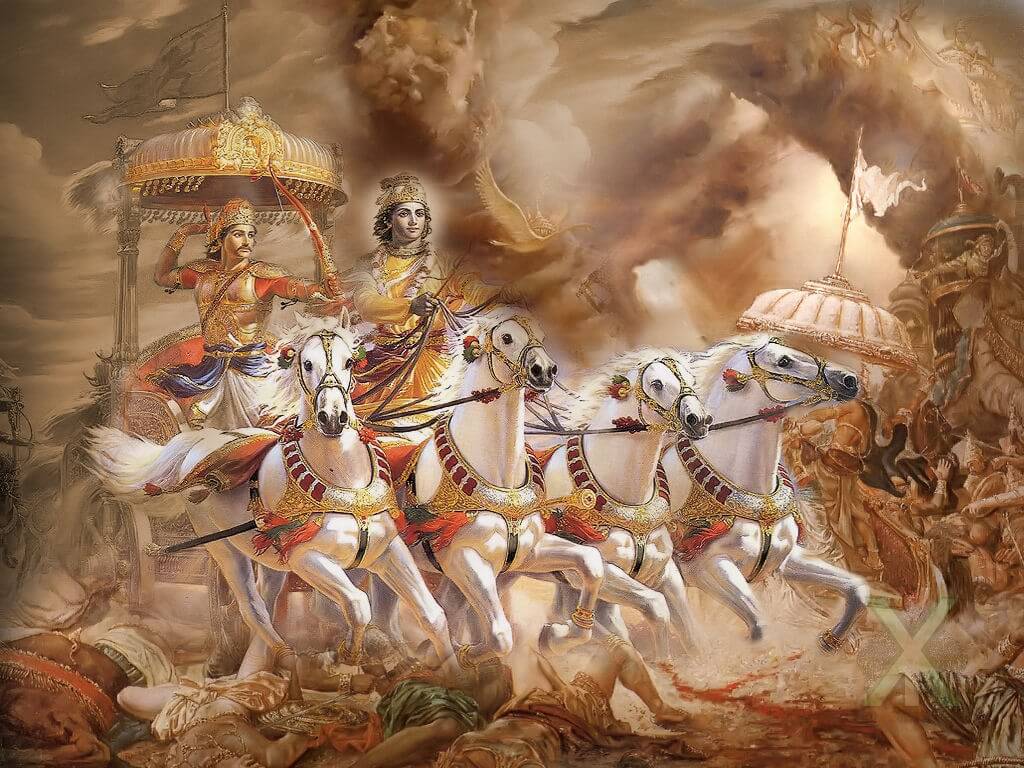

The quotes above echo throughout yoga history with prominence in the Bhagavad Gita and Patanjali’s Yoga Sutras.
The Katha Upanishad is the first time that ‘yoga’ is seen as a ‘spiritual’ discipline. The main method is to withdraw the mind inwards away from the sense objects, and we find the earliest mention of pratyāhāra and dhāraṇā practices.

The Katha Upanishad, describes Yoga as a means to control the mind by restraining the senses.

The Upaniṣads don’t share much more ‘technique’ about the practices than what was given in the Vedas. Mostly, they tell a lot of stories and use large metaphors to deal with our dilemma of being caught up in the body and senses. They build up a philosophical picture, but don’t give clear instructions about the practices yogis actually did to have these experiences. But at least we know that some of the practices we do on our mats have been around for thousands of years.

© Heather Elton Photography. Nath yogi at Ellora Caves in Maharastra, India.
Six limbs of yoga are prescribed in the Maitrī Upaniṣhad, 6.18: Restraint of the breath (prāṇāyāma), withdrawal of the senses from their objects (pratyāhāra), meditation (dhyāna), maintaining (dhāraṇā), thinking (tarka), concentrating (samādhi). (This article would be endless if I include a quote from the Upaniṣads about each technique. Let’s save it for the Level 2 Yoga Philosophy article. These techniques are discussed later in the Hatha Yoga section of this article. But, for a brilliant synopsis on prāṇāyāma, through yoga’s history, read Daniel Simpson’s article ‘Yogic Breathing’. http://www.danielsimpson.info/archive/yoga-breathing-pranayama-sahapedia)
Here are the few instructions that are given: Śvetāśvatara Upaniṣad, (2.8-15), describes āsana, or posture, as sitting straight, and gives advice on how and where to practice, as well as signs of accomplishment.
How to Sit

The Power of Meditation
Meditation is the essence of practice in the Upaniṣads. The performance of all the sacrifices, described in the Maitrayana-Brahmana, “is to lead to a knowledge of Brahman, to prepare a man for meditation. Therefore, let such man, after he has laid those fires, meditate on the Self, to become complete and perfect. But who is to be meditated on?”
And,

Yoga should be done in the right location.

Self-discipline is necessary on the path.

Metaphysical Body
More esoteric concepts like nāḍīs (channels) and chakras (energy wheels), vayus (winds), koshas (sheaths) and tanmatras (elements) are found in the Maitrī Upaniṣad. Suṣhumnā nāḍī is described: when the breath goes out by it (Suṣhumnā) one reaches absoluteness (kevalatva). Prana (breath or vital energy) is explored as the energy of the universe, and as specific ‘winds’ of energy within the body.

Prasna Upanishad identifies 5 different aspects of Prana, or winds in the body that are subsequently named vayus in later yogic texts. Prana, Apana, Udana, Samana and Vyana

The text highlights a network of thousands of channels (nāḍīs) in the body to direct vital energy.

The five Koshas – Annamaya, Pranamaya, Vijnanamaya and Anandamaya are first mentioned in the Taittiriya Upanishad). Yoga works outside in, like peeling an onion:

Katha Upanishad describes the Tanmatras as a metaphysical system of mapping the five elements onto the form of the gross physical body. All three of these systems move from the gross material body to the more subtle energetic ones.

Benefits of Yoga


Ultimate Goal of Yoga
Yoga is accomplished when the mind is retrained, and becomes steady. Then one will know Brahman, and that ātman = Brahman. This is an idea that echoes until medieval times when it appears is the Hatha Yoga Pradipika.

Ultimately, there is liberation through Death. The kind of death that doesn’t involve rebirth. There is the idea that one can attain immortality through yogic practice.

And one must conquer desires for this to happen.

Above, Shankaracharya, founder of Advaita Vedānta (8 CE) and commentator on the Upaniṣads.
Centuries later, The Upaniṣads have become the foundation for Vedānta, the path towards ONENESS, that is the basis of modern Hinduism. It refers to the Brahmanical Vedic stream of thought from the Vedas, Upaniṣads and epics of Classical Yoga, but also includes ideas of the brilliant thinkers from the śramaṇa movement and Buddha’s view on non-dualism. Many of these ideas were recorded in the Brahman Sutra (8 BCE ). It eventually led to Shankaracharya’s philosophical view of non-duality in Advaita Vedānta (8 CE).
Shankaracharya was one the greatest commentators on the Upaniṣads, (especially the classic 12 Upaniṣads which have become the iconic ones, as a result). His systemisation of early philosophical ideas is the basis for modern Hinduism. He is the father of Advaita Vedānta – A + dvaita = “not two-ness” / non-duality. Like the Upaniṣads, Advaita Vedānta uses deductive logic to eventually get to the truth by teaching in ‘negatives.’ ‘Not this. Not this.’ Self-inquiry or Jnana yoga.
I mention this out of the ‘linear time frame’, because it can be confusing. Advaita Vedānta is a synthesis of earlier Upaniṣadic ideas, especially our misapprehension of reality, due to our tendency to separate subject from object, and ourselves from the world. Liberation results from understanding that there is no duplicate – ONE without a second. It retains the non-dualist view of Brahmanical Ātman = Brahman, as well as those of Gautama Buddha.
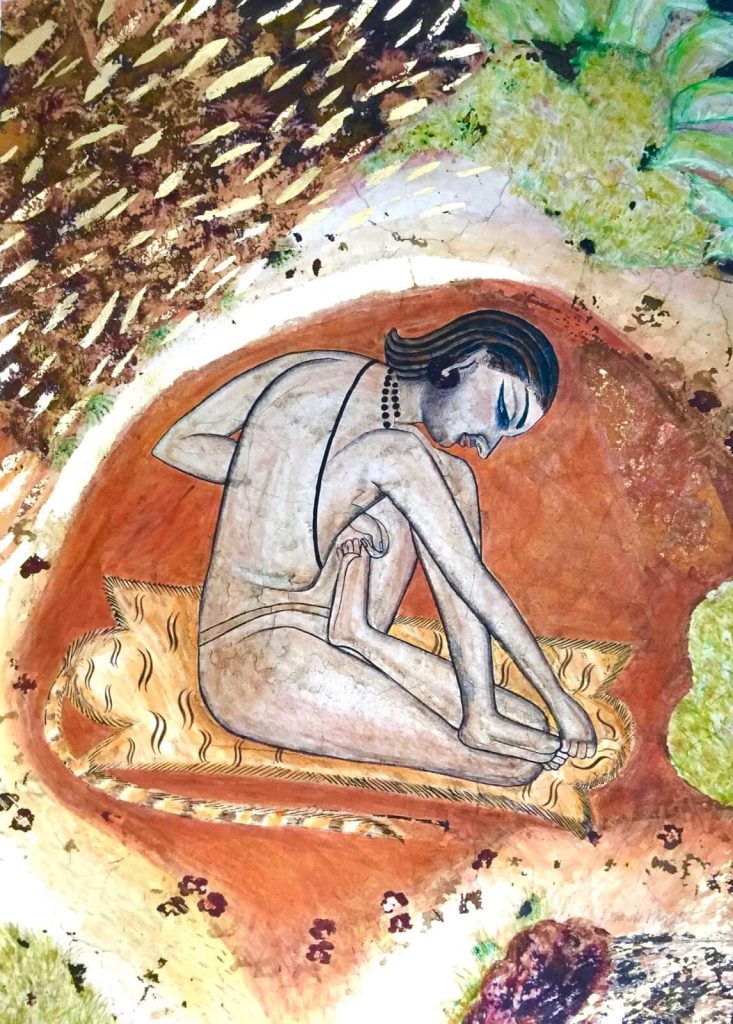
Can Iron Age teachings still be relevant in the 21st century given all the knowledge we’ve acquired in the meantime? Renunciates went into the forest, lived on berries and leaves, and tried to get away from worldly concerns. They were prepared to starve to death in search of liberation. What are our aims when we do Yoga in the contemporary world? The world has changed a lot since 2500 BCE. We live in the digital age and science has become god. Our daily concerns might be different, but perhaps our MIND hasn’t changed that much?
The Upaniṣads, and especially the Maitri Upaniṣad, are relevant in that they influenced ideas in the Epics and Yoga Sutras which have helped to shape yoga as we know it. The recurring technique within the Upaniṣads is mystical and deep philosophical questioning that keeps the mind open to possibility rather than closing down debate into doctrine and dogma.
These yoga traditions are the epitome of human inquiry into reality. They are the result of millions of people over thousands of years investigating the ways the mind works, investigating their own immediate experience of reality. The wonderful thing about an ancient tradition, because there has been so much critical thinking and reflection between schools, and between individual practitioners, is that you start to find, underneath, a universal pattern, practices or principles, no matter what the immediate context or content of the practice is. At the heart of every tradition we have to face ourselves. And we have to face reality.
We’re still trying to find a Self that is behind the story of ‘me’. All of the traditions of yoga are trying to get us to do the ‘inner work’ from wherever we are, in our unique circumstances, and in the process we come across a direct experience of what is happening, and within that an awakening in the core of our heart into the actual nature of consciousness, into the mind. This gives complete freedom. A release from the compulsive searching, from identification with the impermanent forms of the world, identification with the body, identification with self-image, and in that release we are able to appreciate the body, the mind, and the whole natural world in a new way. Yoga is freedom from tradition by fulfilling the very purpose of tradition. And freedom from religion by going into the very heart of reality. ♦
T A K E A W A Y

- Upaniṣads (800-200 BCE) are the last bit of ‘divinely revealed’ philosophical teachings known as Shruti.
- Veda + anta = Vedānta = end of the Veda
- Upa + ni + ṣad = sitting down near
- Liberating insight / experiential wisdom
- Upaniṣads ask The Big Questions
- Main concepts: I am Ātman. Ātman = Brahman. The Real behind the Real. I am Brahman. Brahman = OM. OM contains everything. Everything is ONE.
- Early yoga concepts include: Nāḍīs, Chakras,Vayus, Koshas, and Tanmatras
- A few practical instructions about how to do yoga: How to sit, the right location, self-discipline, meditation, benefits of yoga
- The Chariot metaphor is first used to describe yoga. Yoga is seen as a means to restrain the senses and control the mind.
- Later Upaniṣads | Renunciates | Renouncers | Shramanas | Ascetics. 800 – 250 BCE
- Yogis renounce worldly life and go to the jungles and forests to practice yoga
- Extreme austerity practices developed as a means of purification to dissolve karma. Tapas
- Refusal to accept the Vedas as ‘revealed divine texts’
- Refusal to honour Vedic sacrifice and ritual
- Direct perception vs. priestly authority
- Rejection of the caste system
- Denial of a creator god
- Karma, rebirth, and liberation from the Wheel of Saṁsāra are key concepts. Transmigration of soul can be stopped.
- Jain god Mahavira introduces Ahimsa and Ethics
- Gautama Buddha ‘awakens’ under the bodhi tree. Everything is impermanent. The Middle Path. Extreme asceticism wouldn’t lead to liberation. 4 Noble Truths is a path to endsuffering/Duḥka and offer a way out of the cyclical existence of Saṁsāra.
- Liberation (Mokṣa) is the best word to describe this era.
- Ascetic traditions gave us the word ‘YOGA’ and a spiritual path to follow.
- Non-dualism first emerged as a philosophy with the forest yogis
New concepts emerged from yoga practices:
- Ahimsa – kindness, non-harming
- Duḥka – Suffering, unsatisfactoriness
- Māyā – Illusion
- Saṁsāra – Wheel of birth, death and rebirth
- Mokṣa – Final liberation
- Nirvana – death without rebirth
- Bhakti -Devotion
Definitions of yoga:
- The Chariot metaphor describes yoga as the reining in the senses from the sense objects.
- Yuj (union) is used to describe the union of body, breath and mind.
Yoga practices
- Six limbs: Restraint of the breath (prāṇāyāma), withdrawal of the senses from their objects (pratyāhāra), meditation (dhyāna), maintaining (dhāraṇā), thinking (tarka), concentrating (samādhi)
- Posture or āsana in the sense of sitting straight. Advice is given on how and where to practice, and accompanying signs of successful practice.
Missed the beginning? Start at the top with Part One – A Yoga History in a Nutshell: Introduction
Part 5 on Samkhya Philosophy is coming soon.
This series of articles in A History of Yoga is intended for students on my 200-hour Yoga Teacher Training programs and explores the philosophy and practice of yoga throughout it’s history. Many of the ideas are inspired by the teachers who have taught Yoga Philosophy on my Yoga Teacher Training programs. Emil Wendel, Jim Mallinson, Mark Singleton, Ian Baker, John Weddepohl, Daniela Bevilacqua, Matthew Clark, Daniel Simpson and Ruth Westoby. The Hatha Yoga Project and Centre of Yoga Studies at SOAS, and online courses with Seth Powell (Yogic Studies), have also been influential. As always, deep gratitude to my guru, Dzongsar Jamyang Khentsye Rinpoche, for his presence and teachings. 🙏🏽 Any misrepresentations of facts or dharma are totally of my own doing for which I’m sorry.

